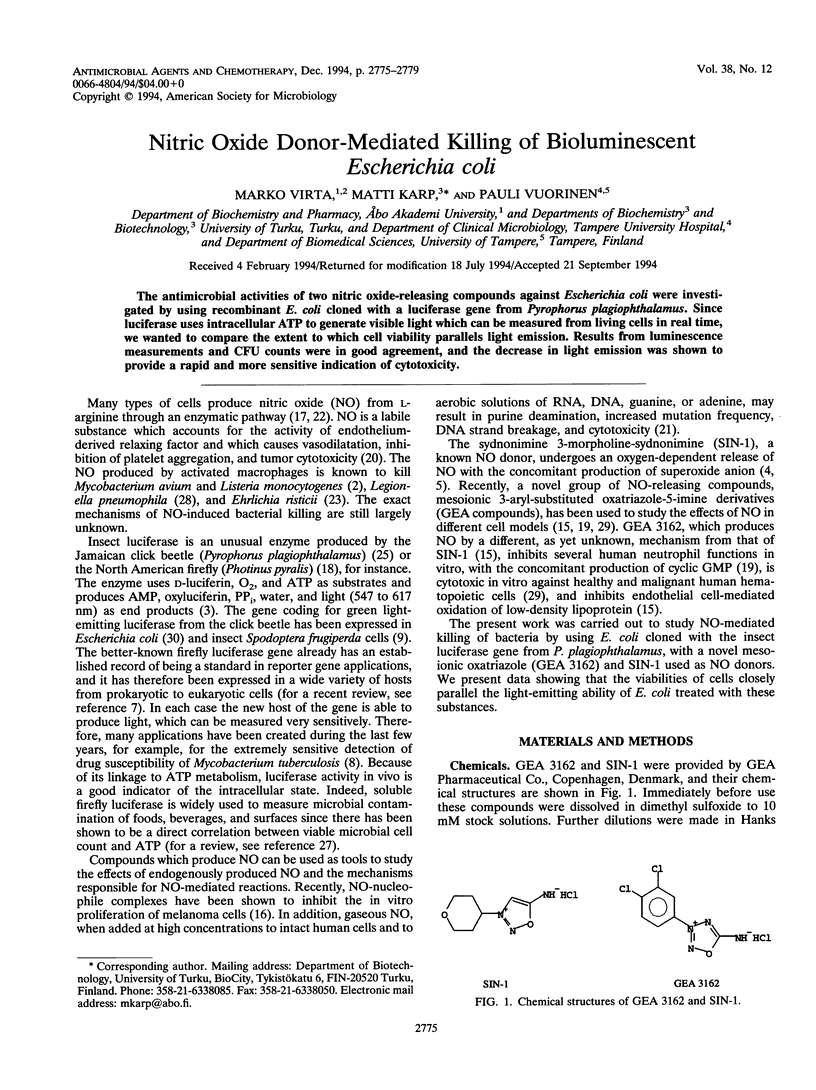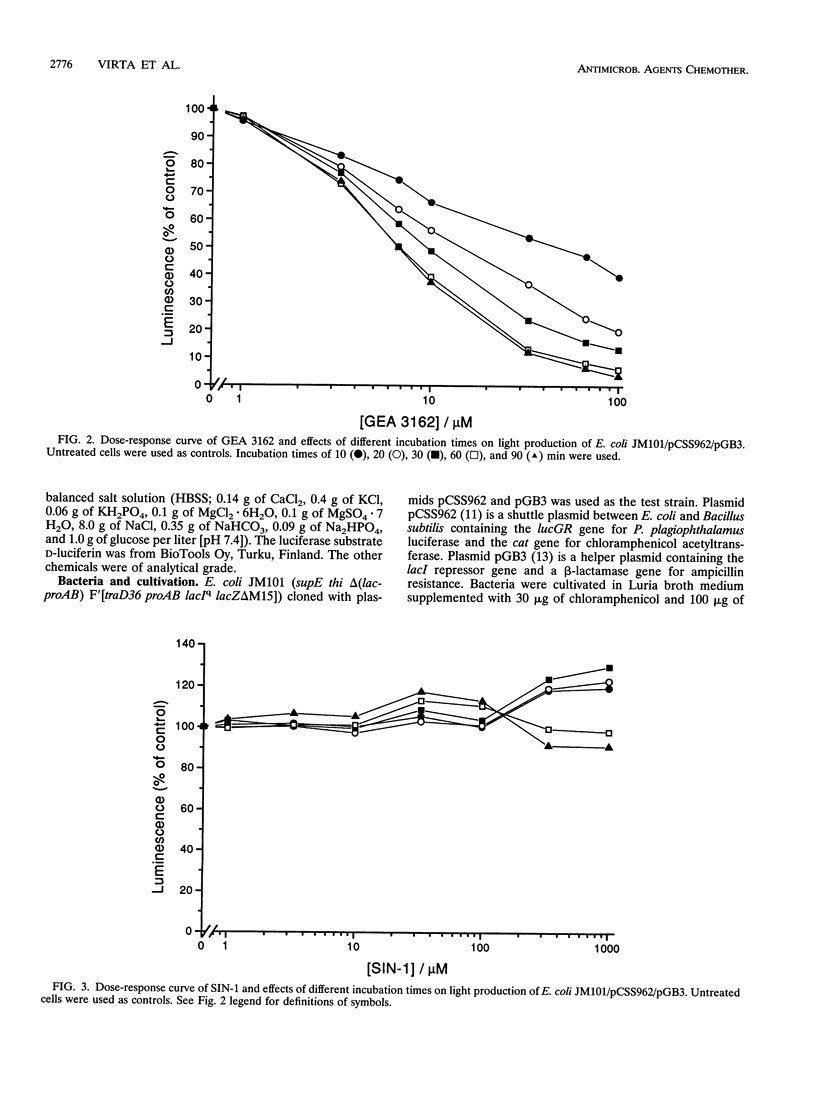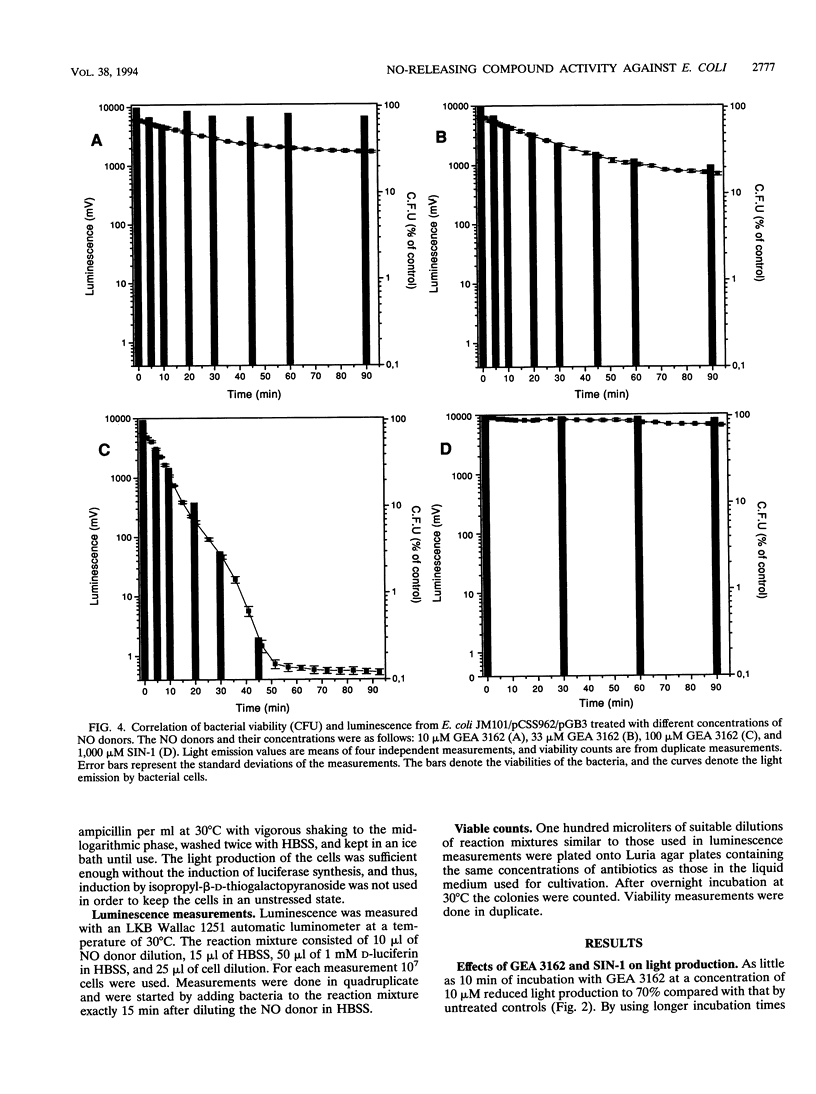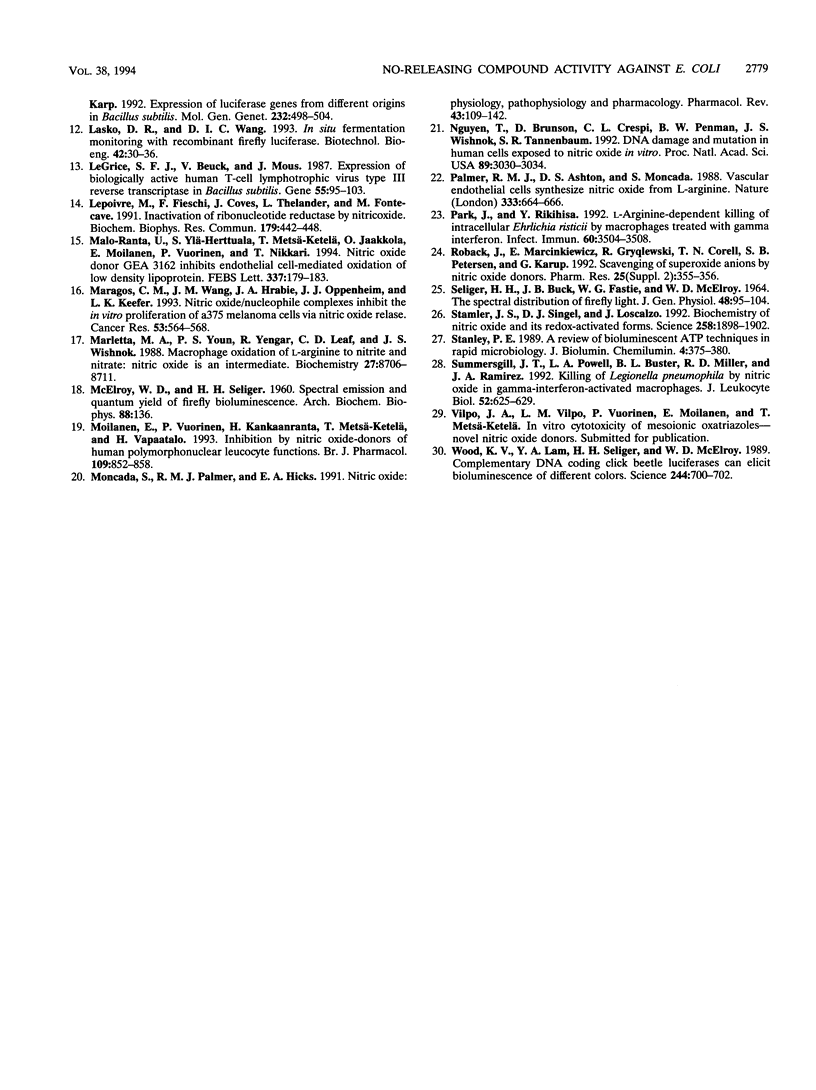Abstract
The antimicrobial activities of two nitric oxide-releasing compounds against Escherichia coli were investigated by using recombinant E. coli cloned with a luciferase gene from Pyrophorus plagiophthalamus. Since luciferase uses intracellular ATP to generate visible light which can be measured from living cells in real time, we wanted to compare the extent to which cell viability parallels light emission. Results from luminescence measurements and CFU counts were in good agreement, and the decrease in light emission was shown to provide a rapid and more sensitive indication of cytotoxicity.
Full text
PDF




Selected References
These references are in PubMed. This may not be the complete list of references from this article.
- Beckman J. S., Beckman T. W., Chen J., Marshall P. A., Freeman B. A. Apparent hydroxyl radical production by peroxynitrite: implications for endothelial injury from nitric oxide and superoxide. Proc Natl Acad Sci U S A. 1990 Feb;87(4):1620–1624. doi: 10.1073/pnas.87.4.1620. [DOI] [PMC free article] [PubMed] [Google Scholar]
- Bermudez L. E. Differential mechanisms of intracellular killing of Mycobacterium avium and Listeria monocytogenes by activated human and murine macrophages. The role of nitric oxide. Clin Exp Immunol. 1993 Feb;91(2):277–281. doi: 10.1111/j.1365-2249.1993.tb05895.x. [DOI] [PMC free article] [PubMed] [Google Scholar]
- Biggley W. H., Lloyd J. E., Seliger H. H. The spectral distribution of firefly light. II. J Gen Physiol. 1967 Jul;50(6):1681–1692. doi: 10.1085/jgp.50.6.1681. [DOI] [PMC free article] [PubMed] [Google Scholar]
- Feelisch M., Ostrowski J., Noack E. On the mechanism of NO release from sydnonimines. J Cardiovasc Pharmacol. 1989;14 (Suppl 11):S13–S22. [PubMed] [Google Scholar]
- Hibbs J. B., Jr, Taintor R. R., Vavrin Z. Macrophage cytotoxicity: role for L-arginine deiminase and imino nitrogen oxidation to nitrite. Science. 1987 Jan 23;235(4787):473–476. doi: 10.1126/science.2432665. [DOI] [PubMed] [Google Scholar]
- Hill P. J., Stewart G. S., Stanley P. E. Bioluminescence and chemiluminescence literature. Luciferase reporter genes--lux and luc. Part 2. J Biolumin Chemilumin. 1993 Sep-Oct;8(5):267–291. doi: 10.1002/bio.1170080507. [DOI] [PubMed] [Google Scholar]
- Jacobs W. R., Jr, Barletta R. G., Udani R., Chan J., Kalkut G., Sosne G., Kieser T., Sarkis G. J., Hatfull G. F., Bloom B. R. Rapid assessment of drug susceptibilities of Mycobacterium tuberculosis by means of luciferase reporter phages. Science. 1993 May 7;260(5109):819–822. doi: 10.1126/science.8484123. [DOI] [PubMed] [Google Scholar]
- Karp M., Akerman K., Lindqvist C., Kuusisto A., Saviranta P., Oker-Blom C. A sensitive model system for in vivo monitoring of baculovirus gene expression in single infected insect cells. Biotechnology (N Y) 1992 May;10(5):565–569. doi: 10.1038/nbt0592-565. [DOI] [PubMed] [Google Scholar]
- Lampinen J., Koivisto L., Wahlsten M., Mäntsälä P., Karp M. Expression of luciferase genes from different origins in Bacillus subtilis. Mol Gen Genet. 1992 Apr;232(3):498–504. doi: 10.1007/BF00266255. [DOI] [PubMed] [Google Scholar]
- Lasko D. R., Wang D. I. In situ fermentation monitoring with recombinant firefly luciferase. Biotechnol Bioeng. 1993 Jun 5;42(1):30–36. doi: 10.1002/bit.260420105. [DOI] [PubMed] [Google Scholar]
- Le Grice S. F., Beuck V., Mous J. Expression of biologically active human T-cell lymphotropic virus type III reverse transcriptase in Bacillus subtilis. Gene. 1987;55(1):95–103. doi: 10.1016/0378-1119(87)90252-6. [DOI] [PubMed] [Google Scholar]
- Lepoivre M., Fieschi F., Coves J., Thelander L., Fontecave M. Inactivation of ribonucleotide reductase by nitric oxide. Biochem Biophys Res Commun. 1991 Aug 30;179(1):442–448. doi: 10.1016/0006-291x(91)91390-x. [DOI] [PubMed] [Google Scholar]
- Malo-Ranta U., Ylä-Herttuala S., Metsä-Ketelä T., Jaakkola O., Moilanen E., Vuorinen P., Nikkari T. Nitric oxide donor GEA 3162 inhibits endothelial cell-mediated oxidation of low density lipoprotein. FEBS Lett. 1994 Jan 10;337(2):179–183. doi: 10.1016/0014-5793(94)80269-6. [DOI] [PubMed] [Google Scholar]
- Maragos C. M., Wang J. M., Hrabie J. A., Oppenheim J. J., Keefer L. K. Nitric oxide/nucleophile complexes inhibit the in vitro proliferation of A375 melanoma cells via nitric oxide release. Cancer Res. 1993 Feb 1;53(3):564–568. [PubMed] [Google Scholar]
- Marletta M. A., Yoon P. S., Iyengar R., Leaf C. D., Wishnok J. S. Macrophage oxidation of L-arginine to nitrite and nitrate: nitric oxide is an intermediate. Biochemistry. 1988 Nov 29;27(24):8706–8711. doi: 10.1021/bi00424a003. [DOI] [PubMed] [Google Scholar]
- Moilanen E., Vuorinen P., Kankaanranta H., Metsä-Ketelä T., Vapaatalo H. Inhibition by nitric oxide-donors of human polymorphonuclear leucocyte functions. Br J Pharmacol. 1993 Jul;109(3):852–858. doi: 10.1111/j.1476-5381.1993.tb13653.x. [DOI] [PMC free article] [PubMed] [Google Scholar]
- Moncada S., Palmer R. M., Higgs E. A. Nitric oxide: physiology, pathophysiology, and pharmacology. Pharmacol Rev. 1991 Jun;43(2):109–142. [PubMed] [Google Scholar]
- Nguyen T., Brunson D., Crespi C. L., Penman B. W., Wishnok J. S., Tannenbaum S. R. DNA damage and mutation in human cells exposed to nitric oxide in vitro. Proc Natl Acad Sci U S A. 1992 Apr 1;89(7):3030–3034. doi: 10.1073/pnas.89.7.3030. [DOI] [PMC free article] [PubMed] [Google Scholar]
- Palmer R. M., Ashton D. S., Moncada S. Vascular endothelial cells synthesize nitric oxide from L-arginine. Nature. 1988 Jun 16;333(6174):664–666. doi: 10.1038/333664a0. [DOI] [PubMed] [Google Scholar]
- Park J., Rikihisa Y. L-arginine-dependent killing of intracellular Ehrlichia risticii by macrophages treated with gamma interferon. Infect Immun. 1992 Sep;60(9):3504–3508. doi: 10.1128/iai.60.9.3504-3508.1992. [DOI] [PMC free article] [PubMed] [Google Scholar]
- SELIGER H. H., BUCK J. B., FASTIE W. G., MCELROY W. D. THE SPECTRAL DISTRIBUTION OF FIREFLY LIGHT. J Gen Physiol. 1964 Sep;48:95–104. doi: 10.1085/jgp.48.1.95. [DOI] [PMC free article] [PubMed] [Google Scholar]
- SELIGER H. H., McELROY W. D. Spectral emission and quantum yield of firefly bioluminescence. Arch Biochem Biophys. 1960 May;88:136–141. doi: 10.1016/0003-9861(60)90208-3. [DOI] [PubMed] [Google Scholar]
- Stamler J. S., Singel D. J., Loscalzo J. Biochemistry of nitric oxide and its redox-activated forms. Science. 1992 Dec 18;258(5090):1898–1902. doi: 10.1126/science.1281928. [DOI] [PubMed] [Google Scholar]
- Stanley P. E. A review of bioluminescent ATP techniques in rapid microbiology. J Biolumin Chemilumin. 1989 Jul;4(1):375–380. doi: 10.1002/bio.1170040151. [DOI] [PubMed] [Google Scholar]
- Summersgill J. T., Powell L. A., Buster B. L., Miller R. D., Ramirez J. A. Killing of Legionella pneumophila by nitric oxide in gamma-interferon-activated macrophages. J Leukoc Biol. 1992 Dec;52(6):625–629. doi: 10.1002/jlb.52.6.625. [DOI] [PubMed] [Google Scholar]
- Wood K. V., Lam Y. A., Seliger H. H., McElroy W. D. Complementary DNA coding click beetle luciferases can elicit bioluminescence of different colors. Science. 1989 May 12;244(4905):700–702. doi: 10.1126/science.2655091. [DOI] [PubMed] [Google Scholar]


